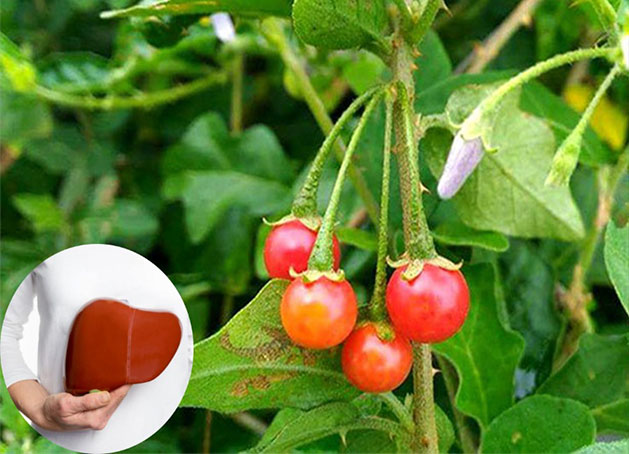Cauliflower is also known by other names such as: sedges, beads, twigs, twigs, twigs, and luu.
Scientific name Solanum hainanense or Solanum procumbens Lour., belongs to the Solanaceae family.
The tree grows wild in many places in our country such as the northern provinces to Hue, Laos, Cambodia.
The prickly pear is a small tree, living for many years, about 1m long, much branched, spreading young branches, covered with star-shaped hairs and many yellow curved spines. Leaves alternately oval or oblong, leaf blade shallow, irregular, dark green above, pale underside, covered with white hairs, both sides have spines in the main vein, especially the upper surface, petiole also thorny. White flowers grow into cymbal. Berries, globose smooth, with long stalks, yellow, red when ripe, yellow seeds.
Parts used are roots (like family roots), strings (like family roots). Roots, twigs and whole fruits, collected all year round, washed, chopped, dried or dried. Sometimes used fresh.
The main chemical components such as roots have alkaloids, starch, and flavonoids. It has alkaloids. The plant is used to treat rheumatism, tooth decay, pain in tendons and bones, flu, cough, whooping cough, allergies. Also used to treat venomous snake bites, detoxify alcohol, beer, prevent motion sickness.
Currently, prickly pear has been researched and proven to be effective in treating viral hepatitis, cirrhosis and supporting the treatment of liver cancer. Daily use 16 – 20g in the form of decoction.
A number of studies on the use of prickly pear have given very good results as a medicine for hepatitis, especially active chronic hepatitis B, while this medicine is often too expensive and has many effects. extra.
In addition, it also has the effect of rapidly reducing clinical symptoms of fatigue, right lower quadrant pain, yellow urine, yellow skin and mucous membranes… At the same time, the drug does not cause unwanted effects on experimental and clinical .
Passion fruit has been researched and proven to be effective in treating viral hepatitis, cirrhosis and supporting liver cancer treatment.
Oriental medicine believes that prickly pear has a slightly bitter taste, warm properties, slightly toxic, has the effect of dispersing rheumatism, back pain, bone pain, detoxification, expectoration, expectoration, cough, pain relief, hemostasis, and snakebite treatment. , hepatitis, cirrhosis, fatty liver. Remedies from prickly pear:
– Cure hepatitis, cirrhosis, support against cancer-causing cells: thorn thorns (stems, roots, leaves) 30g, periwinkle 10g, serrated dogwood (lepidoptera) 10g. All yellow stars, excellent drink daily a ladder.
– Treatment of low back pain, aches and pains: 10g climbing thorns, 10g brocade ropes, 10g spirit clothes, 10g blood millet, 10g guise leaves. Gold star, excellent drink on 1 month. Continuous from 10 to 30 months.
– Cure whooping cough, asthma: Cabbage creeper 10g, Tianmen 10g, butt pulse 10g. Sac day 1 scale divided by 3.
– Remedies used to treat colds, allergies, whooping cough, back pain, bone pain, rheumatism, snakebite: Dosage is 16 – 20g of roots or stems of prickly pear leaves to drink daily.
– Making alcohol: According to experience, prickly pear is used to treat alcohol poisoning very well. 100g of dried bitter gourd with 400ml of water to 150ml, drink during the day, should be taken while the medicine is still warm. Or 50g dried prickly pear with boiling water, for drunk people to drink instead of water. Use until sober.
– Cure cough due to sore throat: Roots or stems and leaves of prickly pear 15g, lemon leaves 30g, excellent drink twice a day. Drink while the medicine is still warm.Use for 5-7 days.
– Support treatment of liver diseases (hepatitis B, cirrhosis…): 35g of prickly pear root or stem with 1 liter of water, 300ml divided and taken 3 times a day, helping to lower liver enzymes, and detoxifies the liver very well.
Some things to keep in mind when using prickly pear to treat liver disease
– The origin of the drug needs to be carefully checked: the supply of medicinal herbs should be strictly controlled, in terms of quality, origin…
– Confusion between varieties. As a family, it is possible to confuse the prickly pear with the tomato, the poison ivy, the wild eggplant, especially those who are not professionals and after the medicinal herbs have been preliminarily processed…
If the drug is not of good quality, it will not only make the use of bitter gourd not only ineffective, but also can cause poisoning, burden the liver, make the disease worse, need to be consulted for medication by professional physician.



Đánh giá
Chưa có đánh giá nào.